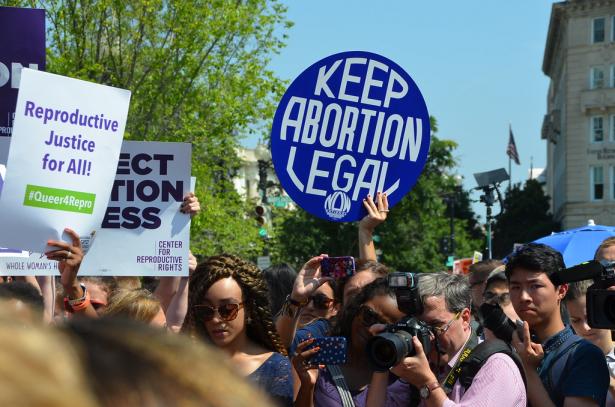There is a straight line from America’s broken systems of democracy to the Supreme Court’s catastrophic majority ruling in Dobbs v. Jackson Women’s Health. That’s because both abortion access and systems of civic participation and representation are essential for autonomy and equality.
Abortion enables people to exercise self-determination over their bodies and their family lives so that they are not rendered second-class citizens by the unique burdens of pregnancy and childbearing. A functioning democracy protects these very same values: political self-determination requires voters to be able to effectively choose who governs, and the ballot lets voters defend themselves against policies that threaten their rights.
Below, Brennan Center experts examine these failings and what lies ahead.
Fair Elections and Reproductive Freedom Go Hand in Hand
By Ian Vandewalker
The movements to eliminate abortion and restrict the vote are both undergirded by many of the same powerful forces. Before it overturned Roe v. Wade, the conservative majority on the Supreme Court spent the past decade slashing campaign finance laws, hobbling the Voting Rights Act, and allowing partisan gerrymandering.
Today, many states that have enacted restrictive voting laws, like Arizona, Georgia, and Texas, have also pushed constraints on abortion access. And major corporations like AT&T and Coca-Cola have made donations to state lawmakers who advance both voter suppression and abortion restrictions.
Anti-abortion rhetoric is even showing up in campaigns for secretary of state, a position that has no role in the regulation of health care. In Arizona and Michigan, election denial candidates running on lies about the 2020 race being “stolen” from Trump have also weighed in on the abortion debate.
In our post-Roe, post-Dobbs future, protecting and expanding access to abortion necessarily entails participating in the fight for fair elections. Everyone who values autonomy and equality must redouble their commitment to both.
In Many States, Gerrymandering Blocks the Abortion Policy the Public Wants
By Sonali Seth and Michael Li
The majority opinion in Dobbs asserts that women need not worry about the impact of the decision on reproductive autonomy because they can turn to the political process and vote out lawmakers who pass abortion restrictions and bans. But the reality is that by failing to rein in partisan gerrymandering and consistently gutting voting rights protections, the Supreme Court has rendered that impossible.
Consider Texas, home to one of the nation’s most restrictive and controversial abortion laws. Partisans there aggressively redrew legislative maps during last year’s redistricting to transform a once competitive state legislature into a safely Republican one. Before, Democrats only needed to win a little more than half the vote to be favored to win control of the Texas House. After brazen redrawing of the maps, they now need to win more than 56.2 percent of the vote to be favored to win even a bare majority. Meanwhile, Republicans only need 43.9 percent for a majority.
Such game rigging to create unaccountable enduring partisan majorities — greenlit by the Supreme Court in 2019 in Rucho v. Common Cause — stands in stark contrast with maps drawn by more neutral bodies.
For instance, in Michigan, the independent commission created by voters converted maps that had been biased in favor of Republicans into ones where both major parties have a reasonable chance to win control. Likewise, in North Carolina, state courts relying on the state constitution threw out maps designed to guarantee Republicans a supermajority and put in place a balanced alternative, making it much less likely that Republicans will be able to override a gubernatorial veto.
Unfortunately, the Supreme Court has abdicated responsibility for making sure that the checks and balances in our democratic system work. It is now up to voters to fight for reforms — at both the state and federal level — to ensure voters can, in fact, make their voices heard when politicians get it wrong.
The Supreme Court Has Undermined the Tools It Says Can Be Used to Protect Abortion Rights
By Madiba Dennie
The Supreme Court has dealt a critical blow to both bodily and political autonomy. Recognizing the overwhelming popularity of abortion rights and public support for the precedent of Roe v. Wade, the Court’s majority offers the franchise as a rotten olive branch of sorts: the opinion paradoxically suggests citizens in each state can vote about the legality of abortion while simultaneously ignoring the Court’s own role in dismantling crucial voting protections and making people’s full citizenship conditional on their reproductive status.
Among a host of damaging decisions, two stand out. In Shelby County v. Holder, the Supreme Court hollowed out Section 5 of the Voting Rights Act, dramatically weakening the federal government’s ability to prevent discriminatory laws from going into effect. Then in Brnovich v. DNC, the Court gutted Section 2, hindering voters from challenging these laws in court after enactment.
The Supreme Court’s open hostility toward voting rights and abortion rights has enabled a surge of laws undermining both. Last year, for instance, 18 states passed 34 laws making it harder to vote, accounting for over one-third of all restrictive voting laws passed in more than a decade. These state laws are curtailing the political participation of people of color. And at least 16 states have passed laws banning abortion before viability, intentionally defying the constitutional standard espoused in Roe.
Perversely, communities of color are disproportionately harmed by both forms of restrictions. And the consequences are troublingly connected. As the Supreme Court once recognized — and as data has since borne out — abortion is essential to “the ability of women to participate equally in the economic and social life of the nation.” Voting, too, is critical for people’s ability to participate in their sociopolitical community and exercise some say over the governance of their lives. Voter suppression and state reproductive control are, therefore, mutually reinforcing, working in tandem to curb civic and political participation, especially for women of color.


Spread the word